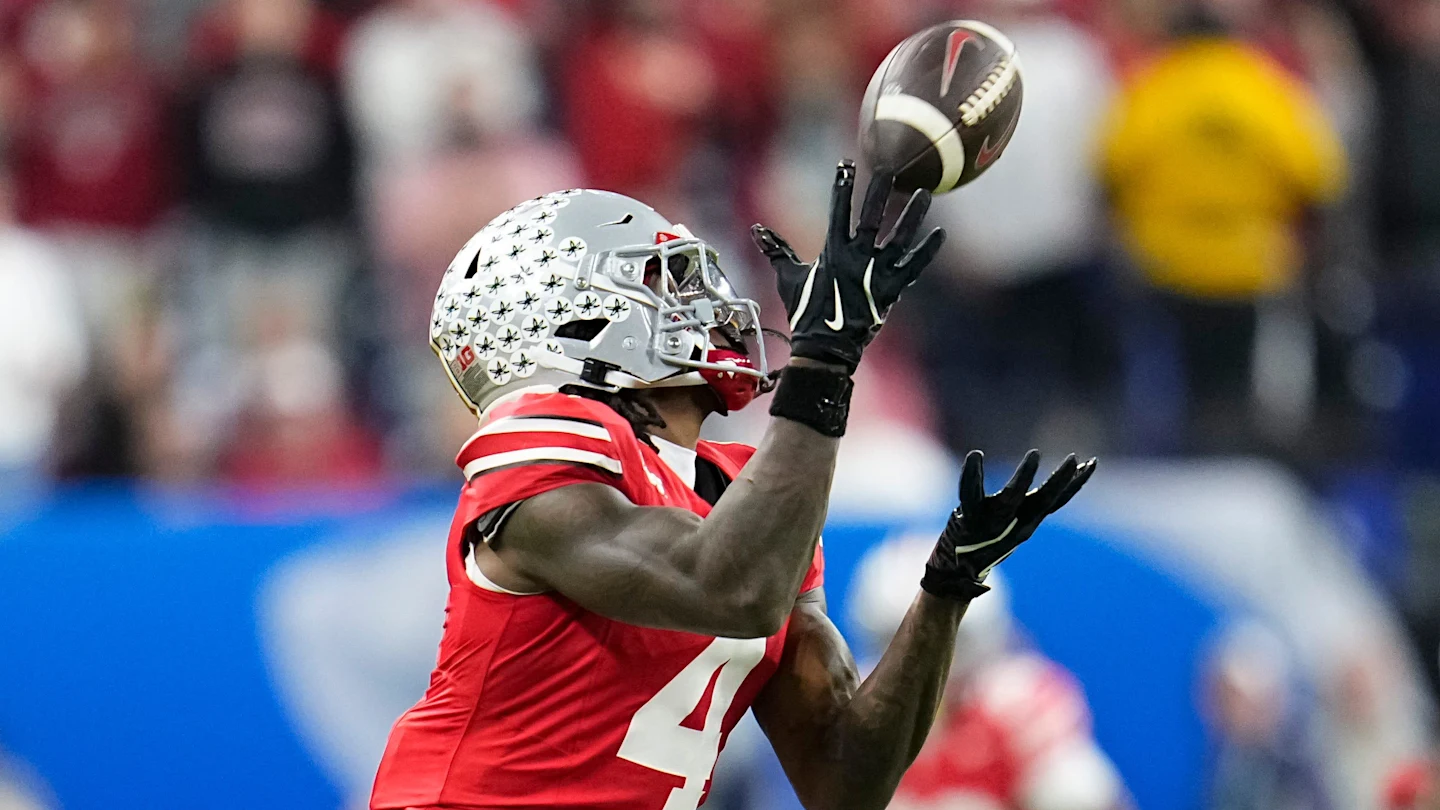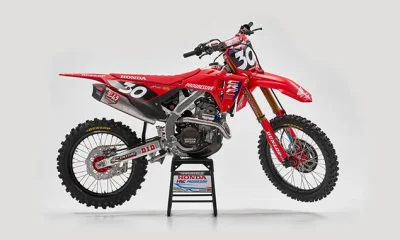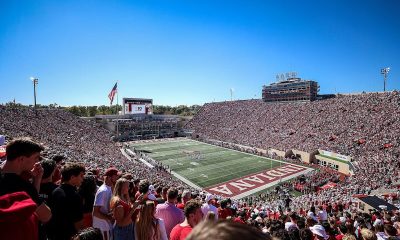NIL
USC student



USC’s student-athletes got a chance to test the NIL waters.
Trojan athletes gathered at Galen Center on Monday for an opportunity to learn more about Name, Image and Likeness (NIL) and how they can capitalize on their brands at the 2025 USC NIL Brand Summit.
USC’s NIL General Manager Lyndsey Lopes opened the event with a brief session for student-athletes. She shared tips about defining core values, identifying an audience and aligning unique values with brands of interest.
Students then had the opportunity to put what they learned into action by introducing themselves to brand representatives from companies like Lululemon, Chick-fil-A, Red Bull and Yeti.
“The goal was really to focus on athlete and brand interaction,” Lopes said. “We really wanted to make sure that this was an opportunity to practice… those pitches and… network directly with the brand.”
One brand that many student athletes seemed drawn to throughout the evening was Power Relief Pain Cream, a patented formula that takes a “natural back door approach to pain”, according to a brochure available on the table for the company. The all-natural, science-based and patented product can be used for pain relief and performance recovery. In addition, because it blocks inflammatory enzymes and nerve signaling for pain, athletes can also use it before practicing or competing.
“We want to meet athletes who are into all natural pain relief and health and wellness and healthy living,” CEO Felice Soule said. “And those are the kind of athletes we want to work with.”
The student-athletes recognized the value in building confidence and learning how to best represent themselves to potential partners.
“I think it’s really cool to have all of these diverse brands come and set up to help every USC athlete and their future,” men’s water polo goalie Charlie Mills said. “I’m excited for the opportunity NIL has brought to USC… and how USC is embracing NIL and providing all of these opportunities for its athletes.”
NIL was established in 2021 and is an ever-changing influence in the world of college sports. The NCAA is currently in the process of settling a case that would financially reimburse former Division I athletes for lost NIL opportunities, establish a revenue-sharing model for all Power Five schools, increase scholarship spots and implement roster cuts.
Safe to say, there’s a lot to keep up with.
“I think what [USC has] always leaned on was developing the student-athlete to make sure that they’re supported throughout the process,” Lopes said. “While this is an extremely exciting opportunity, it can also be overwhelming to balance all these things, but the opportunities are endless.”
While USC has embraced the NIL space by hosting educational events like Monday’s summit, some athletes believe there is still more work to be done to provide equal opportunities between sports.
“I’m on the women’s water polo team,” junior women’s water polo goalie Jada Ward said. “We don’t really have many NIL opportunities, so I think it was important for me and my teammates to come out and meet all the brands.”
Many people are familiar with the multi-million dollar brand deals that sweep media headlines, but Lopes emphasized the importance of partnership authenticity that might not come from a large social media presence or celebrity status.
“What we try to teach at USC is that everyone has a story, everyone has a unique alignment to a brand,” Lopes said. “You never know what a brand is looking for… they’re not necessarily looking at the [social media] following; they could be maybe looking at the type of athlete, the testimony and the storytelling.”
USC Senior Associate Athletic Director for Strategic Communications & Brand Advancement Cody Worsham spoke about the unique advantages that USC athletes have when going to negotiate NIL deals for themselves.
“The advantage that they have is they get to partner with the USC brand, which is timeless, which is traditional, which is global,” Worsham said. “And then they get to come meet these other brands and do NIL deals with them. So it’s really a trifecta and it’s a perfect relationship between all three brands. So it’s exciting to see that.”
Because of the opportunities USC athletes have, many are looking to see how they can utilize their personal brand and partner with companies in collaborative ways.
“We see what they have and then see what I have, and my personality, my platform, and just see how we can combine and how we could grow both of our brands together,” freshman women’s basketball forward Vivian Iwuchukwu said.
Beach volleyball freshman Kennedy Coakley echoed Iwuchukwu’s thoughts about what she hopes to find in an NIL partnership.
“What I’m looking for in an NIL partner is a brand who really embodies how I play on the court, my character, my values, my morals, just a brand that’s all around good,” Coakley said. “Someone that I can really connect to, but can also respect who I am and how I play my sport.”
Coakley is represented by KVA Sports and hopes to take advantage of her agency to grow the connections that she made during the summit.
The USC men’s volleyball team signed a team deal with TravisMathew at the end of January, becoming the first ever college sports team to ink a partnership with the apparel company. As a result, the team received a line of apparel ahead of their trip to Ohio State. Redshirt sophomore outside hitter Riley Haine had a connection with TravisMathew that helped make the deal possible.
“That was really cool,” Haine said. “My friend there, Evan [Ponce] is the guy who does NIL stuff, and it was cool to just get him in contact with our team and our coaches, and he made the whole thing happen. It was super cool to bring all the gear to the guys: new backpack, new shirts, new polos. Their stuff is great too, so it was awesome.”
Women’s water polo redshirt sophomore Caitlin Cohen is the founder and owner of Pomp Clothes, a clothing line described as “Fashion for Fans”. The USC attacker hopes to see how she can use Pomp to strategically partner with brands.
“I’d definitely love to work with different brands and different people,” Cohen said. “I’m definitely just learning, and I have an entrepreneurship minor, which has taught me to tell my story and the meaning behind Pomp. So I guess moving forward, collaborating with people would be super awesome for me to learn and grow.”
With all of the exciting opportunities for student-athletes, USC hopes to see many of them realize their potential off and on the field or court.
NIL
Brendan Sorsby, DJ Lagway could be Tennessee football quarterback picks
Updated Dec. 15, 2025, 12:57 p.m. CT
Tennessee football coach Josh Heupel hasn’t announced that the Vols are in the transfer market for a 2026 quarterback, but there are strong indicators.
UT starter Joey Aguilar has exhausted his eligibility unless there’s movement in Diego Pavia lawsuit challenging the NCAA eligibility rules. Time is running out on that possibility.
Redshirt freshman Jake Merklinger is expected to enter the transfer portal, but he hasn’t announced his plans. Freshman George MacIntyre was a lauded recruit, but he barely played for the Vols this season. Five-star freshman Faizon Brandon will enroll in January, but starting a true freshman could be risky in the ultra-competitive SEC with College Football Playoff bids on the line.

If Aguilar can’t return and Merklinger enters the portal, Tennessee will need a transfer quarterback to fill at least a three-person position group. The question is whether the Vols would add a surefire starter or a optional starter to compete with MacIntyre and Brandon.
These quarterbacks have announced they’ll enter the portal when it opens Jan. 2 and could be options for the Vols.
Brendan Sorsby (Cincinatti)
Brendan Sorsby was a three-star recruit in the 2022 class, who has overachieved to become a productive dual-threat college quarterback. He spent two seasons at Indiana, including a redshirt year, and the past two seasons at Cincinnati’s starter.
In his college career, Sorsby has passed for 7,208 yards, 60 TDs and 18 interceptions. And he has rushed for 1,305 yards and 22 TDs. He has tossed more than one interception in only three of his 35 career games.
In the 2025 season at Cincinnati, Sorsby passed for 2,800 yards, 27 TDs and five interceptions. He ranked second in the Big 12 in passer rating. And he rushed for 580 yards and nine TDs.

Sorsby makes a lot of sense for Tennessee. He’s an accurate passer who rarely throws interceptions, and he can run the ball. Last summer, Sorsby told ESPN’s Greg McElroy that Tennessee’s Neyland Stadium is where he’d love to play a game because he watched a couple of games there as a kid.
He is reportedly exploring his NFL draft stock, but a sizable NIL payout likely could keep him in college. He has one season of eligibility remaining.
DJ Lagway (Florida)
DJ Lagway was a five-star recruit and the No. 2 quarterback in the 2024 class, according to 247Sports Composite. At Florida, he displayed flashes of elite talent but also inconsistency, a rash of turnovers and tendency for injuries.
Lagway completed 62% of his passes for 4,179 yards, 28 TDs and 23 interceptions over two seasons with the Gators. And he rushed for 237 yards and one TD. In the 2025 season, Lagway passed for 2,264 yards, 16 TDs and 14 interceptions, which led the SEC.
Lagway would be an intriguing project if Heupel can tap into his talent and reduce his interceptions. He has two seasons of eligibility remaining.

Dylan Raiola (Nebraska)
Dylan Raiola was a five-star recruit and the No. 3 rated quarterback in the 2024 class. He has spent the last two seasons at Nebraska. In November, he suffered a season-ending broken fibula, so any team picking him up must consider that.
Raiola has completed 69% of his passes for 4,819 yards, 31 TDs and 17 interceptions over two seasons. In the 2025 season, he completed 72% of his passes for 2,000 yards, 18 TDs and six interceptions.
Raiola has two seasons of eligibility. He is a five-star talent who appeared to turn the corner as an accurate, productive passer this season.

Kenny Minchey (Notre Dame)
Kenny Minchey, a native of Hendersonville, Tennessee, was a four-star recruit in the 2023 class out of Pope John Paul II. He signed with Notre Dame after initially committing to Pittsburgh.
Minchey showed promise at Notre Dame, but he was squeezed out of competitions for the starting job. In three seasons (including a redshirt year), he completed 23 of 29 passes for 212 yards. And he rushed for 96 yards and two TDs.
Minchey has played only 10 games and never started. He has two seasons of eligibility remaining. If Tennessee added him from the portal, he would not arrive as the surefire starter. Instead, he would compete with MacIntyre and Brandon for the starting job and round out the quarterback group.
Adam Sparks is the Tennessee football beat reporter. Emailadam.sparks@knoxnews.com. X, formerly known as Twitter@AdamSparks. Support strong local journalism by subscribing at knoxnews.com/subscribe.
Get the latest news and insight on SEC football by subscribing to the SEC Unfiltered newsletter, delivered straight to your inbox.
NIL
Jon Sumrall donating $100,000 to Tulane’s NIL fund
Dec. 15, 2025, 12:33 p.m. ET
Whenever Tulane’s run in the College Football Playoff comes to an end, so too will Jon Sumrall’s time at the school, with the second-year Green Wave coach headed to Florida.
Before he departs, though, he’ll be leaving something behind for his soon-to-be-former employer.
Sumrall and his wife, Ginny, are making a $100,000 donation to the Green Wave Talent Fund, a university initiative to expand NIL opportunities for Tulane athletes, the school announced on Monday, Dec. 15.
In two seasons with the Green Wave, Sumrall went 20-7, including an 11-2 mark this year that helped them win the American Conference and earn a spot in the playoff, where they’ll take on Ole Miss in the first round on Saturday, Dec. 20.
Though he was hired away by Florida late last month, he’ll be coaching Tulane throughout the playoff. That transition has been aided by the Green Wave hiring one of Sumrall’s assistants, pass game coordinator Will Hall, as his successor.
“Tulane University and New Orleans are special to me and my family,” Sumrall said in a statement. “Ginny and I are honored to support the Green Wave Talent Fund because we believe in the vision of Tulane Athletics and want to contribute to the continued success of its student-athletes. The future is incredibly bright, and we are excited for Will Hall and his family to be part of it.
“Coach Hall possesses a keen understanding of Tulane University and its football program, along with a passion that greatly benefits the Green Wave. As a leader, he cares deeply about helping others reach their full potential and is dedicated to equipping them to achieve that goal in every way possible. He has our family’s full support, and we wish him nothing but success as he leads Tulane Football!”
The money could be useful for Tulane, which has excelled under Sumrall despite losing talented players to bigger programs with more NIL resources. After the 2024 season, the Green Wave lost starting quarterback Darian Mensah and leading rusher Makhi Hughes to Duke and Oregon, respectively, with Mensah signing a deal worth a reported $8 million.
Since accepting the position at Florida, Sumrall has joked about balancing two FBS head-coaching jobs at once. His profile photo on X, the social media platform formerly known as Twitter, is a picture of him in half Florida attire and half Tulane attire. In a post last week, he wrote that “I’ve got 2 Phones, 2 Jobs & 2 hours of sleep.”
In four years as a head coach, Sumrall is 43-11. Prior to Tulane, he spent two years at Troy, where he went 23-4 and won a pair of Sun Belt championships. At Florida, he’ll take over a struggling program that has finished with a losing record in four of the past five seasons.
NIL
Georgia Sues Former Linebacker in NIL Case That Could Set Precedent

The University of Georgia Athletic Association (UGAA)’s NIL lawsuit against former linebacker Damon Wilson II, who transferred to Missouri earlier this year, could become a standard type of litigation as more and more athletes sign NIL deals with one school and then transfer to another.
The specific legal dispute is straightforward: UGAA claims that Wilson, 20, breached his NIL contract with Classic City Collective (CCC)—a Georgia-aligned former NIL collective—and failed to pay a liquidated damages provision that was triggered upon breach.
A four-star recruit from Venice High School (Fla.), Wilson played for the Bulldogs in the 2023 and 2024 seasons and, while on the Tigers in 2025, earned second-team All-SEC recognition as he amassed nine sacks—tied for third-best in the SEC.
According to litigation records at Athens-Clarke County (Ga.) Superior Court, Wilson signed a 13-month, $500,000 NIL deal with CCC on Dec. 21, 2024. The deal runs from Dec. 1, 2024, to Jan. 31, 2026 and was contingent on Wilson being enrolled as a student at Georgia and part of the football team. He was paid $30,000, his first monthly licensing fee payment, on Dec. 25, 2024. UGAA emphasizes that Wilson accepted this payment, meaning the contract went into effect. On Jan. 6, 2025, Wilson announced he was entering the transfer portal, a move that Georgia says constituted a breach of the NIL deal. About a week later Wilson withdrew from Georgia and began the process of transferring to Missouri. It’s unknown how much money Wilson received to transfer to Missouri.
Georgia moved to close CCC over the summer, when U.S. District Judge Claudia Wilken granted final approval of the House settlement, and has partnered with Learfield on NIL matters. Relevant to the school’s dispute with Wilson, CCC assigned its Wilson contract to UGAA, meaning the athletic association has the legal right to enforce the contract.
UGAA argues that under the NIL deal’s liquidated damages clause, Wilson, as the licensor, must pay all remaining license fees that would have been payable. The remaining value, according to court filings, is $390,000.
In May, attorney Spence Johnson wrote a demand letter to Wilson on behalf of CCC. The letter told Wilson that while CCC “does not want to unnecessarily undermine your financial future,” CCC also “insists that its student athletes be accountable for promises they make.” Wilson was told he had 14 days to pay or else CCC would “pursue legal action against you based on your breaches” of the NIL deal.
In August, Johnson wrote another letter to Wilson. Johnson said that UGAA had been assigned Wilson’s NIL deal with CCC. The letter indicated Wilson didn’t pay as demanded and that the NIL deal calls for arbitration to resolve disputes. In October, UGAA, through Johnson, filed a lawsuit to compel arbitration, with the complaint stating that Wilson hasn’t responded to demand for arbitration. There is no attorney listed for Wilson and it does not appear from the court docket he has responded to the litigation.
The actual legal controversy—alleged breach of contract—is ordinary, but the circumstances are extraordinary. A university, through its athletic association, is suing a former student athlete who transferred for reneging on his NIL deal.
A lawsuit like UGAA v. Wilson would have been inconceivable five years ago, but in the new college sports world, it’s the kind of case that could become more common.
Through antitrust litigation and accompanying settlements, college athletes can now transfer without sitting out of sports for a period of time. That approach is consistent with college students in general as they can transfer schools, but typical college students aren’t signing NIL deals.
There’s plenty of money to be made, too, for power conference football players to switch schools. University-aligned NIL collectives can pay athletes, some of whom also stand to benefit from the injunctive relief portion of the House settlement. Participating colleges can directly pay athletes a share of up to 22% of the average power conference athletic media, ticket and sponsorship revenue, with $20.5 million pegged as the initial annual cap. There are thus three buckets of money for some college athletes: revenue share, NIL deals and athletic scholarships.
And playing in college could become something of a career depending on the ultimate trajectory of antitrust litigation brought by Vanderbilt quarterback and former JUCO transfer Diego Pavia—the runner-up for the 2025 Heisman Trophy—and other seasoned college athletes. They wish to continue playing college football past the NCAA eligibility clock, which limits eligibility to four seasons of intercollegiate competition, including JUCO and D-II play, within a five-year period.
College sports, at least football at power conference schools, resembles professional sports—except without free agency restrictions and similar player restraints found in the NFL. Those restraints are lawful because the NFL collectively bargains them with the NFL players association. They are thus protected by the non-statutory labor exemption, which reflects U.S. Supreme Court decisions that provide antitrust immunity for bargained rules relating to wages, hours and other working conditions. The non-statutory labor exemption can’t apply in college football because the athletes are, for now at least, not recognized as employees and under labor law only employees can unionize.
Unless and until college football players are recognized as employees who in turn unionize, cases like UGAA v. Wilson could happen again and again. That’s not necessarily a bad thing, it’s just a reflection of the chaotic blend of pro and amateur sports known as modern day power conference football.
NIL
Billy Napier back in Sun Belt at James Madison. It’s a changed world from Louisiana-Lafayette days

Billy Napier thrived in the Sun Belt Conference before. Now he’s back in taking over at James Madison. But it’s a very different landscape since he won big at…
HARRISONBURG, Va.(AP) — Four years ago, Billy Napier walked away from a Sun Belt Conference powerhouse he had built at Louisiana-Lafayette. It was, in part, because he wasn’t sure how that program would handle the financial challenges of new rules allowing college athletes to profit from their name, image and likeness.
Four years later, Napier is returning to the league with James Madison. And the Dukes’ ability to compete financially was one of the main drivers behind his decision to become the successor to UCLA-bound Bob Chesney.
“This place has what it takes to dominate the competition for sure,” Napier said of a program ranked No. 19 in the AP Top 25 and headed to the College Football Playoff.
Napier went 40-12 in four seasons at Louisiana-Lafayette, dominating Sun Belt competition. His Ragin’ Cajuns won the Western Division all four years he was there and claimed league championships in his final two seasons. He was twice named the league’s coach of the year.
But after posting a 12-1 record and his second Sun Belt title in 2021, Napier left for Florida.
“I stayed at Louisiana after Year 2 when we had opportunities, after Year 3 when we had opportunities,” Napier said. “And we probably, truth be known, would have stayed longer if it wasn’t for NIL. Because we know that was coming. We knew that roster was going to be tough to keep together.”
Changed landscape
Napier went 22-23 at Florida, starting this season 3-4 when he was fired in his fourth year leading the Gators.
As he surveyed the landscape, considering his future, he thought a lot about how college football had changed since he first took over at Louisiana-Lafayette in 2018. The NIL rules allowing college athletes to cash in on their fame went live in summer 2021, while this year marked the arrival of revenue sharing following the $2.8 billion House antitrust settlement.
“It’s very different,” Napier said. “Obviously (revenue sharing) is ultimately a huge difference maker at the Group of Six level. Now, you evaluate jobs relative to alignment, resources — which basically means building infrastructure and hiring a great staff — and then the rev share that allows you to compensate really good players.”
Napier said that, the transfer portal and roster limits following the House settlement have changed the game since he last coached in the Sun Belt.
“But ultimately, football’s football,” Napier said. “We’re going to need to evaluate well. Basically going to recruit a high school cycle each year. Then you’re going to recruit a portal cycle each year. Then start over.”
Those changes aren’t something Napier is thinking about in the abstract.
He jumps right into one of the most awkward positions in the country — seeking to retain players of a CFP-bound team while their current coach presumably is hoping to take some of the Dukes’ top talent with him west to UCLA. (No. 12 seed JMU faces No. 5 Oregon on Saturday night.)
“I’m for transparency,” Napier said. “Let’s rip the Band-Aid off. Who are you taking? And who wants to go?”
Roster management
When Curt Cignetti left JMU for Indiana, he took 13 of the program’s top players with him. That group includes the Hoosiers’ leader in rushing touchdowns (Kaelon Black), its leader in receiving scores (Elijah Sarratt), its leader in pass breakups (D’Angelo Ponds) and its second-leading tackler (Aiden Fisher).
Nine former JMU players started multiple games this season for top-ranked Indiana, which beat then-No. 2 Ohio State for the Big Ten Conference title and is the top seed in the 12-team playoff.
Chesney had to rebuild JMU almost entirely from scratch. He brought in 58 new players his first season.
Athletic director Matt Roan said he and Chesney navigated the entire season with openness and honesty, starting with UCLA’s first inquiries about Chesney after Week 3. That gives him confidence that Chesney and Napier will be able to work simultaneously and professionally toward the future of both coaches’ programs.
“We were very transparent throughout,” Roan said. “The day that UCLA announced that DeShaun Foster was being removed as the head coach, they started calling. And every program in America started calling. And we would have those open, honest conversations about where things could go. We’ve been the adults in the room.”
JMU president Jim Schmidt expressed confidence the Dukes will remain successful under Napier no matter how the fight over players turns out.
“I have no doubt that we may lose some talented players to UCLA,” Schmidt said. “We certainly lost some talented players to Indiana. I believe that we will retain the right players and I believe Coach Billy will bring some great players to round that out.”
Get poll alerts and updates on the AP Top 25 throughout the season. Sign up here and here (AP News mobile app). AP college football: https://apnews.com/hub/ap-top-25-college-football-poll and https://apnews.com/hub/college-football
NIL
Jon Sumrall donating $100,000 to Tulane’s NIL fund

So much for the whole “taking out a full-page ad in the local newspaper” move. Future-former Tulane head coach Jon Sumrall and his wife Ginny have put their money where their mouths are, as on Monday they announced a $100,000 donation to the Green Wave Talent Fund.
The donation will give new Green Wave head coach Will Hall a head start on building upon Sumrall’s success.
“Tulane University and New Orleans are special to me and my family,” said Sumrall. “Ginny and I are honored to support the Green Wave Talent Fund because we believe in the vision of Tulane Athletics and want to contribute to the continued success of its student-athletes. The future is incredibly bright, and we are excited for Will Hall and his family to be part of it.”
“Coach Hall possesses a keen understanding of Tulane University and its football program, along with a passion that greatly benefits the Green Wave. As a leader, he cares deeply about helping others reach their full potential and is dedicated to equipping them to achieve that goal in every way possible. He has our family’s full support, and we wish him nothing but success as he leads Tulane Football!”
Sumrall, of course, has accepted the head coaching position at Florida, which will officially begin at the conclusion of Tulane’s College Football Playoff run. Sumrall is 20-7 with two berths in the American Championship in his two seasons atop the program, building upon the success of Willie Fritz, who went 23-4 with two berths in the American Championship, one conference title, a Cotton Bowl win and an AP No. 9 finish in his final two seasons with the program.
Tulane is one of three programs to play in four straight conference title games (Boise State and Georgia are the others), and the Sumralls’ gift helps Hall build a team that can make it five in a row.
“We are grateful to Jon and Ginny for this incredible gift,” said AD David Harris. “Their leadership and generosity will have a direct and lasting impact on our student-athletes as we continue to grow and elevate Tulane Athletics.”
Hall was Tulane’s offensive coordinator in 2019-20 and returned to New Orleans as passing game coordinator this season. He holds a career 70-50 record as a head coach, including a 25-11 run at West Alabama from 2011-13, a 31-9 mark with two Division II semifinal trips from 2014-16 at West Georgia, and a 14-30 mark over four seasons at Southern Miss.
NIL
The 8 best players in this year’s College Football Playoff

The Heisman hype is finally over, so time to move on to arguing who is actually the best player in this year’s College Football Playoff. There’s no politics, no consideration of position or age or the endless parade of hassle that can make the Heisman drag. The best news– we’ll settle it all (more or less) on the field. Here’s the eight best players in this year’s College Football Playoff.
1. Jeremiah Smith, Ohio State
Smith is the best player in college football as a true sophomore. He caught 80 passes for 1,086 yards and 11 touchdowns this season for Ohio State. Smith put up five different 100 yard receiving games and was by far the prime mover and shaker at the most dangerous big-play passing attack in the nation. Sayin gets the headlines and the Heisman support, but Smith is the most untouchable talent in his entire sport.
2. Fernando Mendoza, Indiana
So he’s not the best, but he’s pretty darn close. The best argument for Mendoza is that few if any quarterbacks could make Indiana take off with the gusto that Mendoza managed all season. Mendoza has thrown for 2,980 yards and 33 touchdowns while running for 240 yards and six more scores. He’s impressively consistent, is a natural leader, and has done things at Indiana that were previously unimaginable. He deserved the Heisman… but he’s not the best player in the CFP.
3. Jacob Rodriguez, Texas Tech LB
The best defensive player in the nation, there’s an argument to be made that Rodriguez is the best overall. He’s already racked up 117 tackles, 11 tackles for loss, four interceptions, and a pair of rushing touchdowns just for fun. He is the engine that makes the ridiculously good Texas Tech defense roll. The only reason he’s not higher than he is would be that Tech’s defense would still be formidable without him. But it probably wouldn’t be in the CFP.
4. Julian Sayin, Ohio State
Yes, it feels like anybody could succeed at QB for Ohio State. But it only feels that way because of how smooth and effortless Sayin makes his job seem. He’s completing 78.4% of his passes on the year for 3,323 yards and 31 touchdowns. If that sounds like video game numbers, it’s because Sayin makes Ohio State’s excellent feel inevitable.
5. Trinidad Chambliss, Ole Miss
No Gunner Stockton or Ty Simpson make an appearance here, but Diego Pavia aside, Chambliss was the class of the SEC. Despite starting the season as a backup, he has 3,016 passing yards and another 470 yards on the ground, with a combined 24 touchdowns. He started his career as a starter with three 300+ yard passing games and has replicated that feat in his last three games heading into the CFP.
6. Louis Moore, Indiana
Moore is one of the great weird stories of the season. A JUCO guy who came to Indiana and played well in the struggilng pre-Cignetti days, he transferred to Ole Miss for 2024. He then returned to Indiana for 2025, sued the NCAA to gain eligibility, and played like a maniac. Moore has 74 tackles and six interceptions. He’s 24 years old, he’s back at a school he originally left, and he’s a magnet for the ball at cornerback.
7. Francis Mauigoa, Miami
Offensive linemen tend to get more blame than credit. They don’t put up massive totals of stats and they get noticed mostly when they pick up a holding penalty or a false start. But Mauigoa is the real deal. He’s helped keep Carson Beck clean, with Miami allowing just 11 total sacks all season. Mauigoa was already great. He almost never gets beat in the trenches and probably is the biggest reason that Miami is even in the CFP.
8. Cashius Howell, Texas A&M
The former Bowling Green edge rusher was an absolute terror to opposing linemen. In the 2025 season, Howell has racked up 14 tackles for loss, including 11.5 sacks. He didn’t just feast off easy opponents– 8.5 of those sacks came in SEC play. Howell’s athleticism allows A&M to play aggressively and freely on defense, with no real fear of mistakes. He’s a game-changer.
-

 Rec Sports3 weeks ago
Rec Sports3 weeks agoFargo girl, 13, dies after collapsing during school basketball game – Grand Forks Herald
-

 Sports3 weeks ago
Sports3 weeks agoUtah State Announces 2025-26 Indoor Track & Field Schedule
-

 Motorsports3 weeks ago
Motorsports3 weeks agoRedemption Means First Pro Stock World Championship for Dallas Glenn
-

 Sports3 weeks ago
Sports3 weeks agoTexas volleyball vs Kentucky game score: Live SEC tournament updates
-

 Motorsports2 weeks ago
Motorsports2 weeks agoJo Shimoda Undergoes Back Surgery
-

 Rec Sports2 weeks ago
Rec Sports2 weeks agoRobert “Bobby” Lewis Hardin, 56
-

 NIL2 weeks ago
NIL2 weeks agoBowl Projections: ESPN predicts 12-team College Football Playoff bracket, full bowl slate after Week 14
-

 Rec Sports2 weeks ago
Rec Sports2 weeks agoHow this startup (and a KC sports icon) turned young players into card-carrying legends overnight
-

 Motorsports5 days ago
Motorsports5 days agoSoundGear Named Entitlement Sponsor of Spears CARS Tour Southwest Opener
-

 NIL3 weeks ago
NIL3 weeks agoIndiana’s rapid ascent and its impact across college football




















































